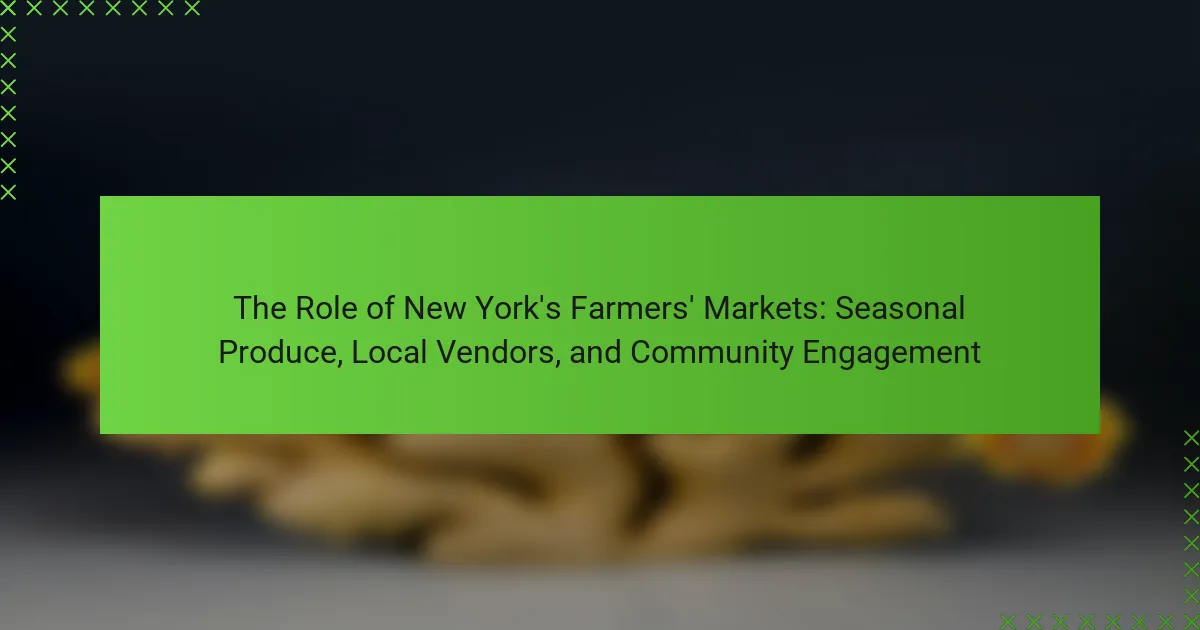
What is the role of farmers’ markets in New York?
Farmers’ markets in New York serve as vital hubs for local food distribution. They connect consumers directly with local farmers and producers. This relationship promotes the sale of fresh, seasonal produce. Farmers’ markets also support local economies by providing income for small-scale farmers. In 2022, New York had over 600 farmers’ markets operating statewide. These markets foster community engagement through events and educational programs. They encourage healthy eating habits by increasing access to fresh fruits and vegetables. Additionally, farmers’ markets often accept various forms of payment, including SNAP benefits, enhancing food accessibility.
How do farmers’ markets contribute to local economies?
Farmers’ markets contribute to local economies by supporting small businesses and increasing local food sales. They provide a direct sales platform for local farmers and artisans. This reduces the need for intermediaries, allowing producers to retain more profits. In 2020, farmers’ markets generated over $2 billion in sales across the United States. These markets also create jobs in the community, from farming to retail. They stimulate local economies by attracting customers who spend money on various goods and services nearby. Additionally, farmers’ markets often promote local tourism, further boosting economic activity. They enhance community engagement by fostering relationships between consumers and producers.
What types of vendors typically participate in New York’s farmers’ markets?
New York’s farmers’ markets typically feature a variety of vendors. These vendors include local farmers who sell fresh produce. They offer seasonal fruits and vegetables grown in nearby regions. Artisanal food producers also participate, selling items like bread, cheese, and preserves. Additionally, vendors may include local meat and dairy suppliers. Some markets feature craft vendors selling handmade goods. Each vendor contributes to the market’s diverse offerings. This variety supports local economies and promotes community engagement.
How do farmers’ markets support local agriculture?
Farmers’ markets support local agriculture by providing a direct sales platform for farmers. This allows them to sell their produce directly to consumers, increasing their profit margins. Farmers’ markets also promote local food systems, which helps sustain regional economies. They encourage community engagement by connecting consumers with local growers. Additionally, these markets often feature seasonal produce, which supports sustainable farming practices. Research shows that farmers’ markets can increase local agricultural sales by up to 50% compared to traditional retail outlets. This direct connection fosters consumer loyalty and awareness of local agriculture.
What seasonal produce is available at New York’s farmers’ markets?
Seasonal produce available at New York’s farmers’ markets includes a variety of fruits and vegetables. In spring, markets feature asparagus, radishes, and strawberries. Summer brings tomatoes, corn, and peaches. Fall showcases pumpkins, apples, and squash. Winter markets may offer root vegetables like carrots and potatoes. These seasonal offerings reflect local agricultural cycles. Farmers’ markets in New York provide fresh, locally sourced produce to the community.
How does seasonality affect the variety of produce offered?
Seasonality significantly affects the variety of produce offered at farmers’ markets. Different crops thrive in specific seasons, leading to varied availability throughout the year. For instance, spring brings fresh greens and herbs, while summer yields tomatoes and berries. Autumn is known for squash and apples, and winter typically offers root vegetables and storage crops. According to the USDA, seasonal produce not only reflects the local climate but also supports sustainable farming practices. This seasonal variation encourages consumers to eat fresh, local food and fosters community connections.
What are the benefits of buying seasonal produce at farmers’ markets?
Buying seasonal produce at farmers’ markets provides numerous benefits. Seasonal produce is often fresher and more flavorful than out-of-season alternatives. This freshness is due to shorter transportation times and reduced time from harvest to sale. Additionally, purchasing seasonal items supports local farmers and boosts the local economy. Research indicates that buying locally can reduce carbon footprints by decreasing transportation emissions. Seasonal produce is typically more affordable, as it is abundant during harvest times. Furthermore, seasonal eating encourages a diverse diet, introducing consumers to a variety of fruits and vegetables throughout the year. This variety can enhance nutritional intake and promote health. Overall, buying seasonal produce fosters community connections and encourages sustainable practices.
How do farmers’ markets foster community engagement?
Farmers’ markets foster community engagement by creating a space for local interaction. They allow residents to meet and connect with local farmers and producers. This direct interaction builds trust and strengthens community ties. Farmers’ markets often host events, workshops, and activities that encourage participation. Research shows that these markets can increase social cohesion in neighborhoods. A study by the American Journal of Public Health found that farmers’ markets contribute to community identity and pride. They also provide access to fresh produce, promoting health and well-being. Overall, farmers’ markets serve as vital hubs for community engagement and connection.
What activities and events are commonly held at farmers’ markets?
Farmers’ markets commonly host a variety of activities and events. These include live music performances that enhance the shopping experience. Cooking demonstrations are frequently held to showcase how to use seasonal produce. Educational workshops on topics like gardening and nutrition often take place. Kids’ activities, such as face painting or crafts, engage younger visitors. Seasonal celebrations, like harvest festivals, attract larger crowds. Local vendors may offer tastings of their products, encouraging sampling. Community events, such as health screenings or fitness classes, promote wellness. These activities foster community engagement and support local economies.
How do farmers’ markets promote social interaction among community members?
Farmers’ markets promote social interaction among community members by providing a communal space for people to gather. These markets often feature local vendors, which encourages residents to support their neighbors. The atmosphere fosters conversation among attendees, creating opportunities for relationship building. Additionally, events and activities at these markets, such as cooking demonstrations and live music, enhance engagement. Research shows that farmers’ markets can increase social ties, as they serve as a hub for community interaction. A study from the Journal of Community Health found that frequent market visitors reported higher levels of social connectedness. This highlights the role of farmers’ markets in strengthening community bonds.
What challenges do farmers’ markets face in New York?
Farmers’ markets in New York face several significant challenges. Limited access to affordable locations impacts market visibility and vendor participation. Strict regulations and permits can complicate the setup process for vendors. Weather conditions often affect attendance and sales, especially during harsh winters. Competition from supermarkets and online grocery services can reduce customer turnout. Additionally, fluctuating consumer preferences can lead to inconsistent demand for local produce. Financial sustainability remains a concern, as many markets struggle with funding and operational costs. These challenges collectively hinder the growth and success of farmers’ markets in the region.
How do weather and seasonality impact farmers’ market operations?
Weather and seasonality significantly impact farmers’ market operations. Weather conditions can affect crop yields and availability. For example, excessive rain can lead to flooding, damaging crops and reducing supply. Conversely, drought conditions can hinder growth, limiting the variety of produce available. Seasonal changes dictate what fruits and vegetables are in season. Markets typically feature more local produce in peak growing seasons, like summer and early fall. This seasonal availability influences consumer attendance and purchasing patterns. In New York, harsh winters can lead to reduced market hours or closures. Conversely, pleasant weather in spring and summer can boost foot traffic and sales. Understanding these dynamics helps farmers and vendors plan effectively for market operations.
What are common logistical issues for vendors at farmers’ markets?
Common logistical issues for vendors at farmers’ markets include limited space, transportation challenges, and inconsistent customer traffic. Vendors often face constraints on booth size, impacting product display. Transportation can be problematic due to the need for suitable vehicles to transport goods. Inconsistent customer turnout can lead to fluctuations in sales, making inventory management difficult. Additionally, weather conditions can affect market attendance, further complicating vendor operations. These issues highlight the complexities of managing a booth at farmers’ markets.
How can consumers maximize their experience at farmers’ markets?
Consumers can maximize their experience at farmers’ markets by arriving early to get the best selection of fresh produce. Visiting early allows shoppers to choose from the freshest items before they sell out. Engaging with vendors is also beneficial; it provides insights into product origins and growing practices. Asking questions can lead to discovering unique items and recipes. Bringing reusable bags helps in carrying purchases efficiently. Planning ahead by checking the market’s schedule and vendor list can save time and enhance the shopping experience. Participating in cooking demonstrations or workshops can offer practical tips and inspiration. Supporting local vendors fosters community engagement and strengthens local economies. These practices contribute to a more rewarding and enjoyable visit to farmers’ markets.
What tips can help shoppers choose the best produce?
To choose the best produce, shoppers should look for freshness, color, and firmness. Fresh produce often has a vibrant color and a firm texture. Shoppers can check for any blemishes or soft spots, which indicate overripeness. Seasonal produce tends to be fresher and more flavorful. Local vendors at farmers’ markets often provide produce that is picked at peak ripeness. Additionally, asking vendors about their growing practices can provide insight into the quality of the produce. Shoppers should also consider organic options, which may have fewer pesticides. Finally, purchasing in-season fruits and vegetables can lead to better taste and lower prices.
How can consumers support local vendors at farmers’ markets?
Consumers can support local vendors at farmers’ markets by purchasing their products directly. Buying fresh produce, baked goods, and handmade items helps sustain local businesses. Engaging with vendors by asking questions builds relationships and fosters community. Sharing their experiences on social media promotes vendors to a wider audience. Participating in market events or workshops enhances community involvement. Providing feedback helps vendors improve their offerings. Additionally, consumers can advocate for farmers’ markets in their communities, increasing visibility and patronage. Supporting local vendors contributes to the local economy and promotes sustainable practices.
The main entity of the article is New York’s farmers’ markets, which play a crucial role in local food distribution and community engagement. The article examines how these markets support local economies by connecting consumers with local farmers and producers, promoting the sale of seasonal produce, and fostering community interactions through various events and activities. It discusses the types of vendors present, the benefits of buying seasonal produce, the challenges faced by markets, and logistical issues for vendors. Additionally, it provides tips for consumers on maximizing their experience and supporting local vendors, highlighting the overall significance of farmers’ markets in enhancing local agriculture and community ties.
